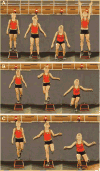Utilization of ACL Injury Biomechanical and Neuromuscular Risk Profile Analysis to Determine the Effectiveness of Neuromuscular Training
- PMID: 27474385
- PMCID: PMC5513480
- DOI: 10.1177/0363546516656373
Utilization of ACL Injury Biomechanical and Neuromuscular Risk Profile Analysis to Determine the Effectiveness of Neuromuscular Training
Abstract
Background: The widespread use of anterior cruciate ligament (ACL) injury prevention interventions has not been effective in reducing the injury incidence among female athletes who participate in high-risk sports.
Purpose/hypothesis: The purpose of this study was to determine if biomechanical and neuromuscular factors that contribute to the knee abduction moment (KAM), a predictor of future ACL injuries, could be used to characterize athletes by a distinct factor. Specifically, we hypothesized that a priori selected biomechanical and neuromuscular factors would characterize participants into distinct at-risk profiles.
Study design: Controlled laboratory study.
Methods: A total of 624 female athletes who participated in jumping, cutting, and pivoting sports underwent testing before their competitive season. During testing, athletes performed drop-jump tasks from which biomechanical measures were captured. Using data from these tasks, latent profile analysis (LPA) was conducted to identify distinct profiles based on preintervention biomechanical and neuromuscular measures. As a validation, we examined whether the profile membership was a significant predictor of the KAM.
Results: LPA using 6 preintervention biomechanical measures selected a priori resulted in 3 distinct profiles, including a low (profile 1), moderate (profile 2), and high (profile 3) risk for ACL injuries. Athletes with profiles 2 and 3 had a significantly higher KAM compared with those with profile 1 (P < .05).
Conclusion: This is the first study to use LPA of biomechanical landing data to create ACL injury risk profiles. Three distinct risk groups were identified based on differences in the peak KAM.
Clinical relevance: These findings demonstrate the existence of discernable groups of athletes that may benefit from injury prevention interventions.
Study registration: ClinicalTrials.gov NCT identifier: NCT01034527.
Keywords: anterior cruciate ligament; biomechanics; female athlete; neuromuscular training; risk profile.
© 2016 The Author(s).
Conflict of interest statement
One or more of the authors has declared the following potential conflict of interest or source of funding: The authors acknowledge funding support from NFL Charities as well as from the National Institutes of Health/National Institute of Arthritis and Musculoskeletal and Skin Diseases (grants R01-AR055563, R01-AR056259, and R01-AR049735).
Figures
References
-
- Agel J, Arendt EA, Bershadsky B. Anterior cruciate ligament injury in National Collegiate Athletic Association basketball and soccer: a 13-year review. Am J Sports Med. 2005;33(4):524–530. - PubMed
-
- Bell AL, Pedersen DR, Brand RA. A comparison of the accuracy of several hip center location prediction methods. J Biomech. 1990;23(6):617–621. - PubMed
-
- Davies PL, Rose JD. Motor skills of typically developing adolescents: awkwardness or improvement? Phys Occup Ther Pediatr. 2000;20(1):19–42. - PubMed
-
- Deitch JR, Starkey C, Walters SL, Moseley JB. Injury risk in professional basketball players: a comparison of Women's National Basketball Association and National Basketball Association athletes. Am J Sports Med. 2006;34(7):1077–1083. - PubMed
MeSH terms
Associated data
Grants and funding
LinkOut - more resources
Full Text Sources
Other Literature Sources
Medical
Research Materials
Miscellaneous


